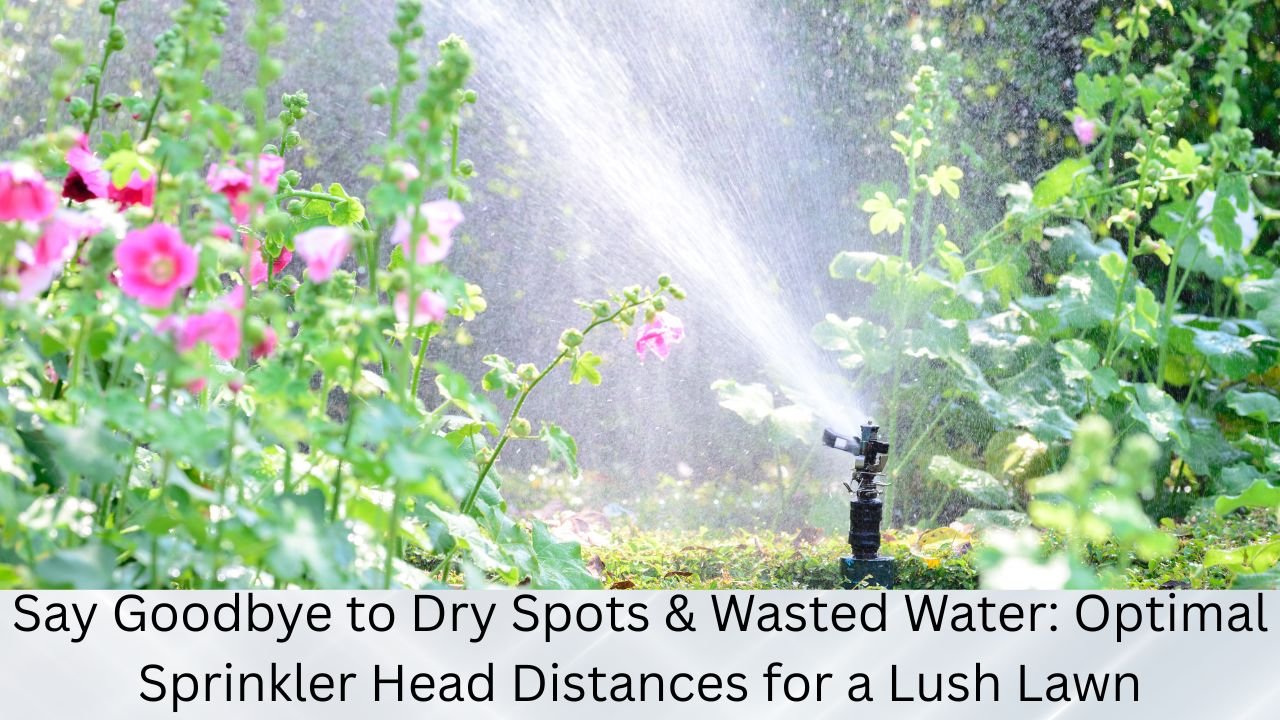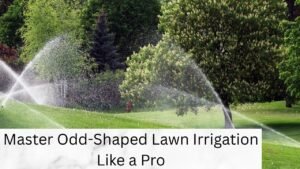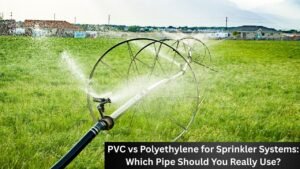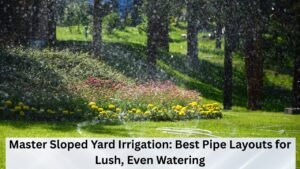When your sprinkler system isn’t spaced right, you’re not just risking a few brown patches. You’re wasting water, inflating your utility bill, and possibly setting your lawn up for disease and stress. Worse? You’ll keep spending weekends adjusting heads that never seem to water evenly. But here’s the fix—optimal sprinkler head distance is the one thing that makes or breaks your irrigation system’s efficiency. Let’s break down exactly how to get it right.

What’s the Real Problem with Poor Sprinkler Spacing?
Bad spacing means:
- Overlap that wastes water and causes puddles
- Gaps that leave dry, stressed areas
- Uneven coverage, which invites fungus, yellowing, or runoff
In short, it’s like painting with a leaky brush—no matter how long you try, you’ll never get full coverage. Learn more in our sprinkler system layout guide.
The fix? Understand head-to-head coverage, precipitation rate, and pressure.
What Is Head-to-Head Coverage?
Head-to-head coverage is the principle of placing sprinkler heads so that each one sprays water all the way to the next head. This ensures complete overlap, avoiding dry spots or uneven watering. As explained in this youtube video below by Denver Water (YouTube, July 2016), proper head-to-head spacing is the backbone of efficient irrigation design.
Head-to-head coverage means every sprinkler’s spray reaches the next sprinkler in the layout. The goal is 100% overlap. Why? Because sprinkler heads don’t spray evenly—the water output is strongest near the center and weakest at the outer edge.
Think of it like this: the outer part of the spray radius is like a mist; without another head nearby, it won’t deliver enough water. By overlapping those weak zones with the strong zone of the next head, you create uniform coverage.
- Ideal overlap: 100%—the outer radius of one sprinkler should hit the midpoint of the next.
- Result: No dry rings, no over-saturation. Just green, even grass.
For more on matching the right heads to this strategy, check out our sprinkler head types comparison.
What’s the Role of Precipitation Rate in Sprinkler Spacing?
The precipitation rate (usually measured in inches per hour) is how much water a sprinkler delivers over time. It’s directly tied to nozzle type and spacing. Here’s why it matters:
- Uniform precipitation = healthy lawn
- High precipitation = runoff risk
- Low precipitation = underwatered zones if not timed right
Let’s make it practical:
“If your heads deliver 0.5 inches/hour and your lawn needs 1 inch/week, you’ll need two 1-hour sessions weekly.”
Then you need matched precipitation nozzles. A quarter-circle should water just as fast as a full-circle.
Want to calculate it precisely? Use our sprinkler water usage calculator.
Choosing the Right Sprinkler Head Type (and Why It Matters)
I break down each type of sprinkler and how it suits different watering needs. The guide in this video below, Types of Sprinklers (YouTube, published about 3 years ago), walks through the options clearly—so readers can pick the best one for their garden.
Spray Heads
- Best for small areas
- Short throw radius
- High precipitation rate
Key Tip: Always use matched precipitation rate nozzles. A quarter-circle nozzle should apply water at the same rate as a full-circle one, or the zone will be uneven.
See our picks for best sprinklers for small lawns to match this head type.
Rotary Nozzles
- Lower precipitation rate
- Ideal for slopes or clay soil
- Gentler spray = less runoff
These are good for areas where infiltration is a challenge. They water more slowly but more deeply.
Rotors
- Long throw distance (up to 50 feet)
- Lower precipitation rate
- Forgiving with minor spacing issues
For detailed head-to-head comparisons, browse our full sprinkler head types guide.
Specialized Heads
- Bubblers/Shrub Heads: Focused watering for individual plants
- Strip Nozzles: For narrow areas like side yards or parkways. Use rectangular spray patterns
Mapping Your Yard: The Foundation of Good Spacing
Before any head gets installed, you need a map:
- Use graph paper or a digital tool
- Sketch the lawn with accurate measurements
- Mark all obstacles: trees, beds, patios, fences
- Note sun exposure and soil type—they’ll affect zoning later
Our sprinkler installation tips for beginners can walk you through mapping and planning.
Understanding PSI: The Pressure Behind Your Spacing
I break down how water pressure works and what PSI really means for your plumbing systems. This quick tutorial from Balkan Sewer & Water Main Service, Understanding Water Pressure And P.S.I. – A Quick Tutorial (YouTube, February 8, 2022), explains it in simple terms. Check for youtube video below:
Water pressure (PSI) directly affects throw distance:
- Low PSI = short throw, larger drops = dry gaps
- High PSI = misting, wind drift = wasted water
Always check dynamic PSI, which means while water is flowing—not just static pressure. It tells you what the sprinkler will actually experience.
Fixes:
- For low PSI: Try pressure-compensating nozzles
- For high PSI: Use inline regulators or heads with built-in regulation
Use our sprinkler water pressure chart to see what each head type requires.
Designing Your Layout: Spacing Patterns That Work
Square Pattern
- Heads placed in corners and edges
- Fill the center with a grid
- Best for rectangular or square lawns
Pro Tip: Use a string line and measuring tape to place heads precisely
Triangular Pattern
- Offset rows for maximum coverage
- Uses fewer heads for large areas
- Better for circular or irregular shapes
Rectangular/Strip Layout
- Needs special strip nozzles
- Throw pattern: narrow width, long length
- Ideal for parkways, narrow side yards
Irregular Areas
Break them into manageable zones or shapes. Use adjustable arc nozzles and create micro-patterns for better control.
These layouts are covered step-by-step in our sprinkler system layout guide.
Wind and Weather: The Overlooked Variables
If your area sees wind speeds above 5–10 MPH:
- Reduce spacing by 10–20% upwind
- Use low-angle or multi-trajectory nozzles to cut wind drift
- Space slightly farther downwind for balance
Don’t design in perfect conditions—design for the real world.
Nozzle Selection: The Unsung Hero of Uniformity
Your nozzle affects:
- Flow rate (GPM)
- Radius/throw distance
- Precipitation rate
Always match nozzles using manufacturer charts. Don’t guess. Choose ones that match your available PSI and area size.
Look into multi-stream, multi-trajectory nozzles for improved wind resistance and better coverage in open or windy zones.
Troubleshooting Common Mistakes: Ask Yourself These
| Question | Likely Issue | Fix |
| Are there dry spots? | Heads over-spaced, PSI too low, or wind drift | Reduce spacing, check pressure, try different nozzles |
| Seeing puddles after a cycle? | Under-spacing or too high precipitation | Switch to lower output nozzles or reduce cycle time |
| One part green, another stressed? | Mixed nozzles or heads in one zone | Use matched precipitation across entire zone |
Explore more in our printable sprinkler troubleshooting flowchart.
Ongoing Optimization: Don’t Set It and Forget It
Proper spacing isn’t a one-time thing—it’s a living system. Every year:
- Walk your system and observe it in action
- Adjust arcs, spacing, or nozzles as needed
- Watch for pressure changes or clogs
Well-spaced heads make everything easier to maintain. You’ll catch issues faster, adjust more easily, and get better results.
Final Thoughts: From Headaches to Head-to-Head Coverage
When you space heads right, you:
- Avoid brown spots and puddles
- Reduce watering time and cost
- Make your lawn thrive without effort
A sprinkler system isn’t just plumbing—it’s a smart water plan. For even more help with setup, use our sprinkler zone calculator to design by the numbers.





